3. Rocket Rods
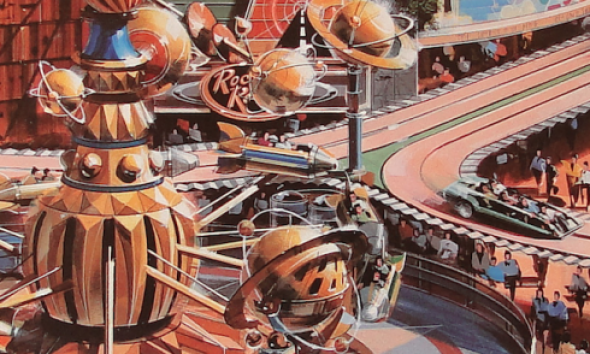 Intended as the centerpiece for Disneyland's golden New Tomorrowland, Rocket Rods stalled. © Disney
Intended as the centerpiece for Disneyland's golden New Tomorrowland, Rocket Rods stalled. © Disney
Location: Disneyland (Anaheim, California)
Lifetime: May 1998 - September 2000 (Intermittant, 30 months)
Video evidence: Point-of-view video
In-Depth: Disaster Files: Rocket Rods
The Story: Besides Honey, I Shrunk the Audience and Innoventions, Rocket Rods was the only notable new addition to Disneyland for its much-touted New Tomorrowland 1998 (which didn't end well - see #8 on this list). The attraction used an early version of the technology behind Epcot’s Test Track and California Adventure’s Radiator Springs Racers to send slot-car style vehicles blasting along an elevated highway high above Tomorrowland, darting in and out of the golden buildings and touring attractions from the inside. The queue made use of the park’s former Circlevision theatre, snaking around between the 360-degree screens that teased at transportation of the future, and of Disneyland’s past.
Why It Failed: The Rocket Rods' early adaptation of Test Track technology left them fickle, with sensors often triggering and closing the ride for hours or days at a time. What’s more, the Rocket Rods replaced the leisurely and beloved Peoplemover, which had glided along the highways of Tomorrowland since 1967.
Walt envisioned his Peoplemover as a sincere prototype for future transportation, briskly and gently carrying guests through Tomorrowland and into a twisted highway of track over the Autopia and Submarine Lagoon. The Rocket Rods not only replaced the beloved Peoplemover, but did so poorly, navigating the same convoluted and iconic overhead track in a fraction of the time. A “thrill” ride, the Rocket Rods accelerated down straightaways before having to slow to a crawl at every un-banked turn in the track. The start-stop maneuver left the experience awkward and wore out tires daily.
The final nail in the coffin for the much-maligned New Tomorrowland, the Rocket Rods closed for good after two and a half years of downtime and frustration, promised to return in April 2001. They never did, and the ride’s queue turned into the Buzz Lightyear Astro Blasters ride in 2005. The Peoplemover track still sits above Tomorrowland, abandoned. The must-read obituary is forever recorded in our Disaster Files: Rocket Rods feature.
2. Universal Studios Escape
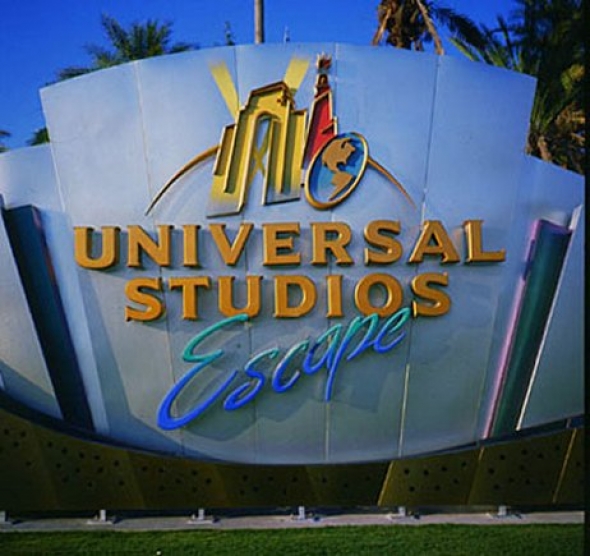 Official logo of the whole "resort" when known as Universal Studios Escape.
Official logo of the whole "resort" when known as Universal Studios Escape.
Location: Orlando, Florida
Lifetime: 1999 - 2002 (3 years)
The Story: One of the least well-known but most egregious flubs in the theme park industry came with the opening of Universal’s Islands of Adventure in 1999. Now recalled as a cutting edge park full of technological innovation and detail that meets and even surpasses even Disney’s best, Universal’s second park in Orlando was quite a mystery for its first year.
That’s because when it opened, the park was named Universal Studios Islands of Adventure. Of course, it was built next to the original Universal Studios Florida as part of the brand-new and much-advertised Universal Studios Escape (which will sound familiar to fans of Nickelodeon and Slime Time Live, which filmed there and famously ended each show with a shout-out to Universal Studios Escape).
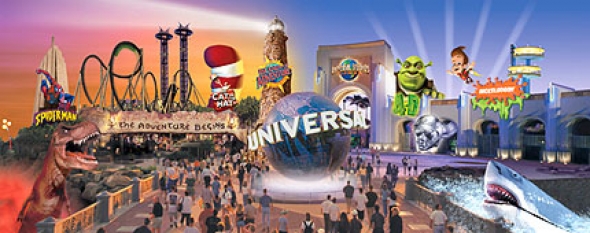 So what is Islands of Adventure? Confused yet?
So what is Islands of Adventure? Confused yet?
Why It Failed: Probably you can spot the issue. “Universal Studios Islands of Adventure at the new Universal Studios Escape” seemed to indicate that these "Islands of Adventure" were nothing more than an addition to the original park. The new park fared miserably in attendance despite having some of the most incredible rides of the era. Universal spent years trying to clarify what exactly Islands of Adventure was, until finally renaming everything. The second park became Universal’s Islands of Adventure, part of the larger Universal Orlando Resort.
It may seem obvious now, but remember that, aside from Walt Disney World, parks weren’t growing into what we would now easily identify as “multi-park resorts” at the time! Universal was inventing its own marketing via the “school of hard knocks.” Their eventual realization of the possessive “Universal’s” moniker and the “Resort” name for the entire complex was doubtlessly a helpful precedent for the many “Resorts” that sprung up soon after. Without Universal taking the brunt of that discovery, we might’ve ended up with “Disneyland California Adventure” at “Disneyland Escape!”
1. Stitch’s Great Escape!
Location: Magic Kingdom; Orlando, Florida
Lifetime: 2004 – present
Video evidence: Stitch's Great Escape point-of-view
Full Story: Disaster Files: Stitch's Great Escape
The Story: Perhaps the most despised Disney attraction of all time, it isn’t necessarily that Stitch’s Great Escape is a horrible attraction (although, subjectively, it probably is). Or that it's a misuse of technology (but it is). Or that it can't live up to its predecessor (though it doesn't). The issue is all of that and then some.
Just like Disneyland got a New Tomorrowland in 1998, Magic Kingdom opened a New Tomorrowland in 1994, based on a “real, working” city of the future. A sort of pop-culture, sci-fi alien spaceport, Tomorrowland had public transportation (Tomorrowland Transit Authority Peoplemover), a launch port (Space Mountain), and a nightclub (Cosmic Ray’s) that all existed in the same continuity. Near the entrance to the land along the stunning Avenue of Planets was the Tomorrowland Interplanetary Convention Center, then rented out by X-S Tech, a Martian technological company eager to show off its newest development: a teleportation pod. This beloved attraction, developed by Disney with George Lucas (of Star Wars fame), was the ExtraTERRORestrial Alien Encounter.
In agreeing to witness X-S Tech’s demonstration to “Seize the Future,” guests were ushered into a pre-show room where an adorable fuzzy alien creature named Skippy would show off the teleportation technology on a small scale, simply being transported between two tubes at opposite ends of the room. Never mind that poor Skippy turns up in the second scorched, charred, and clearly in pain (a "dark side" Disney rarely showed)… on to the main chamber, where X-S Tech’s Chairman Clench will visit us from across the galaxy!
Strapped into chairs arranged in a tiered circle around a massive teleportation tube, the process goes smoothly. Until something stands in the way of the intergalatic beam. As the lights flash, the tube is filled with a disgusting alien creature somewhere between a spider, a grasshopper, and a lizard… with wings. The tube visibly cracks and shatters as the alien escapes into the audience. In pitch-black darkness, cutting edge sound and tactile effects let you feel the alien breathe on your neck and growl in your ear as blood splatters from a worker overhead on the catwalk and warm drool drips down your arm.
Subject to numerous re-writes and re-workings, the attraction was first not scary enough for then-CEO Michael Eisner, and then became too dark (for a brief time, a work-in-progress version had X-S Tech purposefully using humans as gineau pigs with its carnivorous alien). After half a year of soft-openings and testing periods, it opened for good in June 1995. If you want to know more about Alien Encounter, check out the must-read standalone Lost Legends: Alien Encounter that tells the full story.
It closed after eight years in October 2003, and was re-opened just a year later featuring the comical dog-like alien Stitch from Disney’s 2002 film Lilo & Stitch. Instead of being scared for your life, Stitch burps chili dog in your face, spits on the audience, and jumps across your shoulders. It’s horrifying, just not in the same way as Alien Encounter. Skippy and his burned-self are re-used in the pre-show, but as two separate aliens, not with one as a disfigured version of the other.
Why It Failed: The precise failing point of Stitch's Great Escape is impossible to pinpoint. It seems that everything executives hoped the attraction would have going for it turned out to disappoint fans. Alien Encounter was a genius re-use of the circular-seating Mission To Mars show, a uniquely dark story crafted by Disney and George Lucas (before they stumbled across the Forbidden Eye), and made great use of simple effects to create an experience that was good old-fashioned theatrical fun.
Replacing the unique alien with flavor-of-the-week Stitch and his chili dog burps seemed a cop-out. By keeping the gross-out effects and total darkness, but pairing them with a cuddly, comic creature, Disney created a ride that appeals to... well... practically no one. Too intense for kids, too slapstick for teens. It was clearly as hasty re-branding of an attraction deemed "too intense" for the Magic Kingdom.
Unfortunately, the replacement of Alien Encounter rippled. The idea was to serialize Alien Encounter and export copies to Disneyland and Tokyo Disneyland when their Tomorrowlands got their respective renovations. After horrified parents reacted negatively to Magic Kingdom's (ignoring clearly posted signs and the word TERROR in the attraction's name), those plans were dropped. The space earmarked for a copy at Disneyland (already outfitted with the circular seating) was instead turned into a pizza resaurant. It's a shame - with rides based on Indiana Jones and Star Wars, Disneyland park has more in the way of "PG-13" attractions, and Alien Encounter would never have recieved such harsh criticism there.
So that's how Stitch took control of one of the most interesting and retroactively-loved attractions Disney ever made and flubbed it. All the details are contained in an in-depth Disaster Files: Stitch's Great Escape feature. It seems Alien Encounter will never get another lease on life, but at least Stitch's Great Escape seems equally unlikely to ever be duplicated elsewhere.
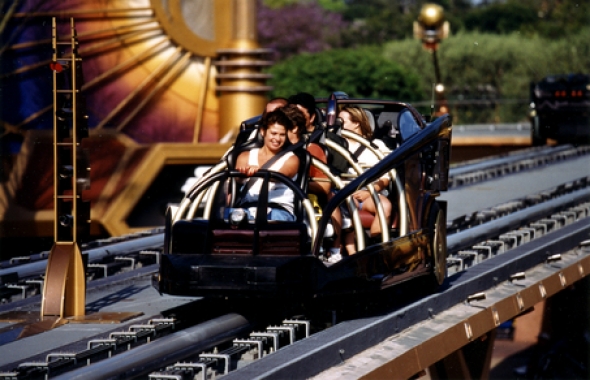
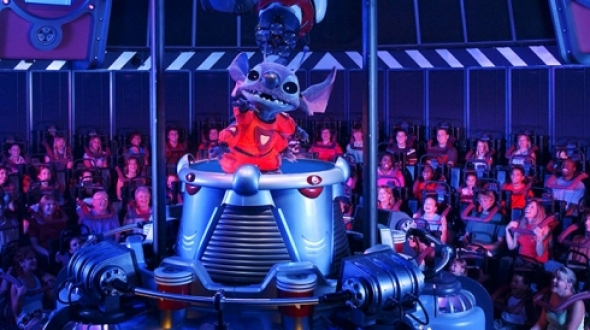
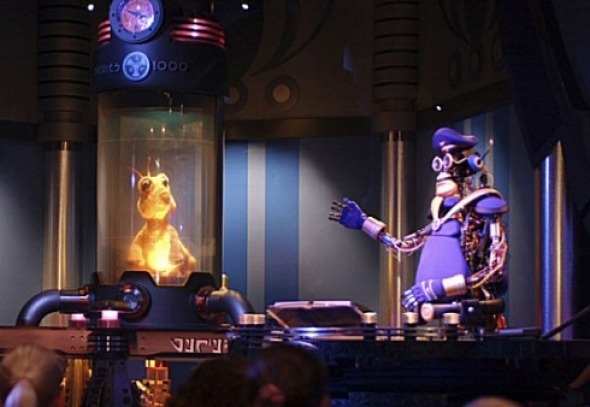
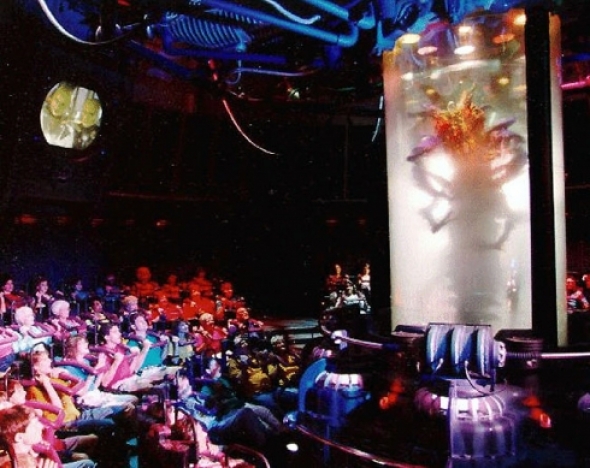
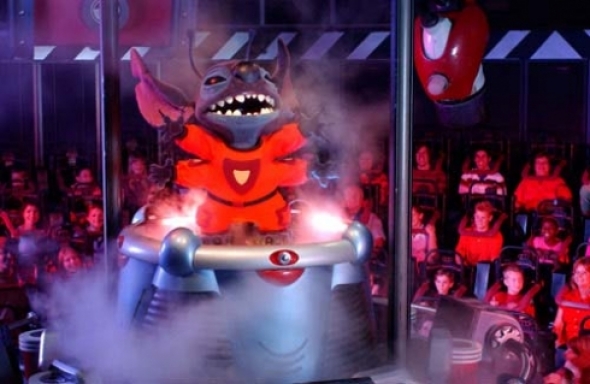
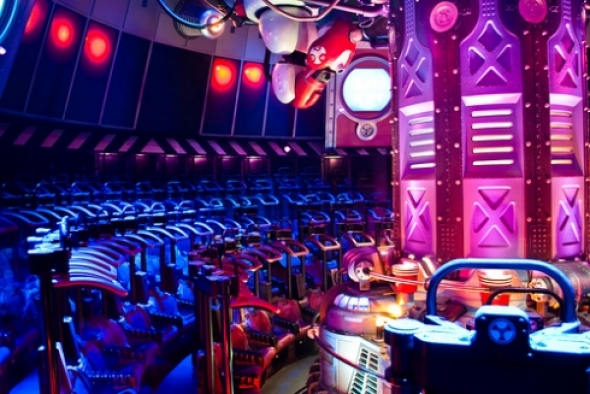

Comments
Islands of Adventure's Poseidon's Fury was a fantastic experience when it originally opened, with a breath-taking surprise ending that left you wondering, "How in the world did they DO that?!" Subsequent re-writes and theme changes left us with a neutered, unsurprising show stripped of a lot of its initial wow-factor. Too bad...
Thank you...I was the senior production designer on Poseidon's Fury. We rented the giant dirigible hangar at El Toro Marine Base to mock up the transition finale. It was a fun project...and there were some very innovative effects, from the "water tunnel" to the bronze "Poseidon Time Lock" and, of course, the seamless transition from the Temple scene back to the first scene. My concern was how long our live actors could keep their characters fresh and on point. I haven't seen the show in years and I heard it had been through some changes. We had a great team on Poseidon's Fury and I enjoyed working on it.
So cool! It's incredibly odd now... You walk from the second chamber, through the water tunnel and... back into the second chamber? Makes for a cool transition when the lights go out and the giant temple appears around you, but it doesn't make a whole lot of sense.
Poseidon's Fury was one of my favorite "adventure" at IOA when it opened. In fact for my very first time, I was so mesmerized by the Time Lock that I thought the water tunnel was some type of projection and not real. And in addition to the cool transition at the end, it was impressive you could feel the blast of heat from the Fire Balls. I'm an architect and was just amazed how quick and soundless the transition occurred. Big Kudos for creating something that took my breath away!
I think you forgot the expensive failure of Buzz Saw Falls at Silver Dollar City in Branson Mo!